Key takeaways:
- Technical difficulties are common in live events; understanding their root causes can help manage challenges effectively.
- Having the right tools, such as a troubleshooting checklist and reliable communication systems, is essential for managing unexpected issues.
- Calmness, adaptability, and collaboration with team members are key strategies for troubleshooting successfully during performances.
- Embracing unpredictability can lead to creative solutions and memorable moments during live shows.
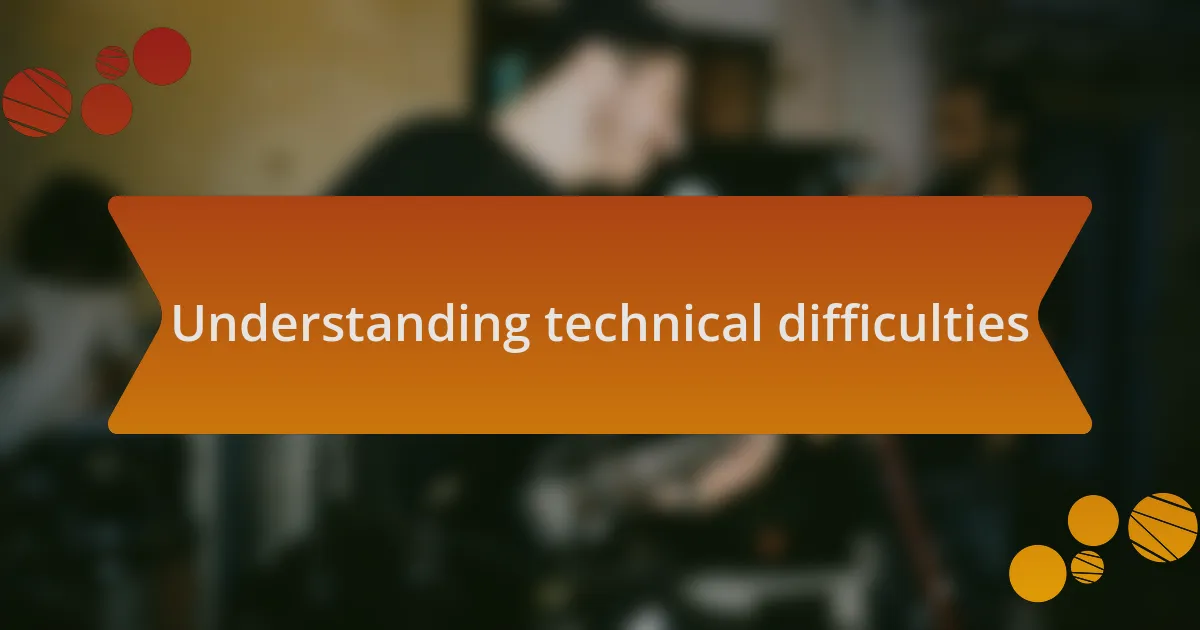
Understanding technical difficulties
Technical difficulties can often feel like a storm brewing in the middle of a show. I remember one night when our sound system suddenly went silent—just as the crowd’s energy peaked. My heart raced as I scanned the room, wondering how I could quickly restore the vibe without losing the audience’s attention.
Understanding the root causes of these issues is crucial. Whether it’s a misplaced cable or a software glitch, identifying the problem can sometimes feel like finding a needle in a haystack. Have you ever felt that rush of panic when something unexpected happens? I certainly have, and it’s in those moments that quick thinking and calmness become your best friends.
I’ve learned that the unpredictability of live events means technical issues are almost inevitable. I’ve started to approach these challenges as opportunities for creativity. Instead of letting frustration take over, I ask myself what I can learn from the experience. How can this mishap make our next performance even better? This mindset has transformed my approach to technical difficulties from daunting to dynamic.
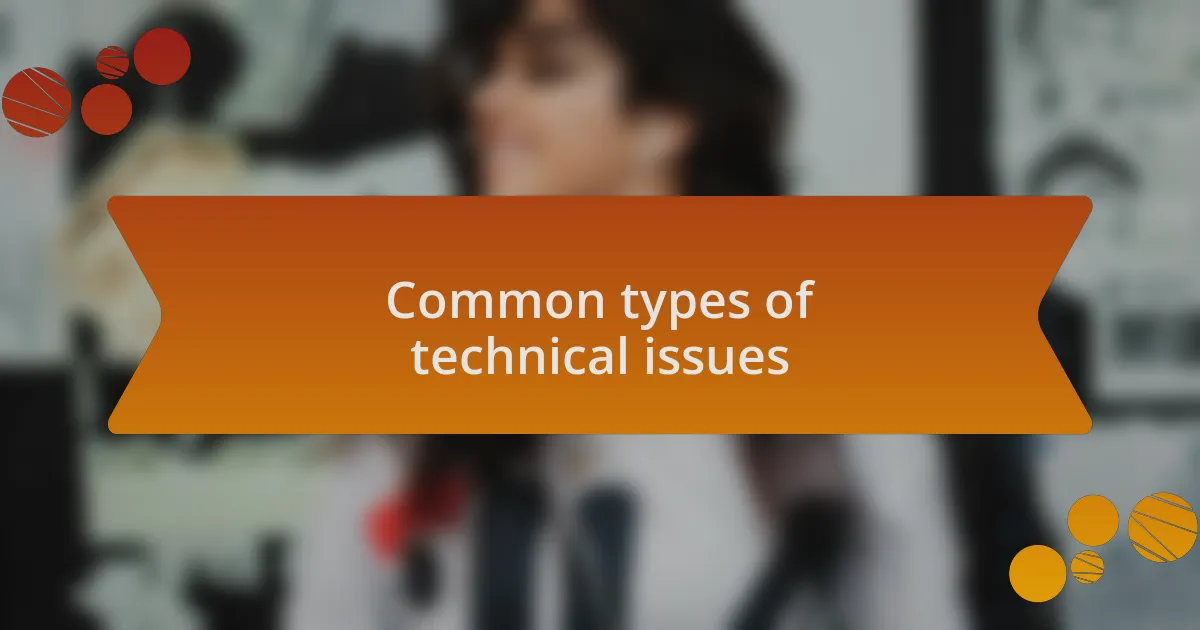
Common types of technical issues
When it comes to live shows, one of the most frustrating technical issues I often encounter is sound distortion. I remember a night when our main speaker started buzzing just as the DJ was about to drop a major track. That unsettling noise made my stomach churn. In those moments, I find myself asking: how can something so small derail an entire performance? It’s a stark reminder of how every component of our setup plays a vital role in the overall experience.
Lighting malfunctions can also throw a wrench into the works. I once had a spotlight go out during a key moment in a performance, plunging the stage into darkness. The mood shifted instantly, and it felt like I was navigating uncharted waters. I realized that navigating these challenges requires not just technical skills but also the ability to adapt on the fly. How do we maintain that electric atmosphere when the lights dim unexpectedly?
Another common issue is connectivity problems, especially with wireless equipment. During a performance, I’ve had microphones that suddenly dropped out, cutting off the artist mid-verse. That panic is palpable in those seconds before I can react. I’ve learned to stay composed and communicate clearly with the team. A quick hand signal or nod can make all the difference while we work to solve the problem seamlessly. After all, how we respond to these challenges can often define the night.
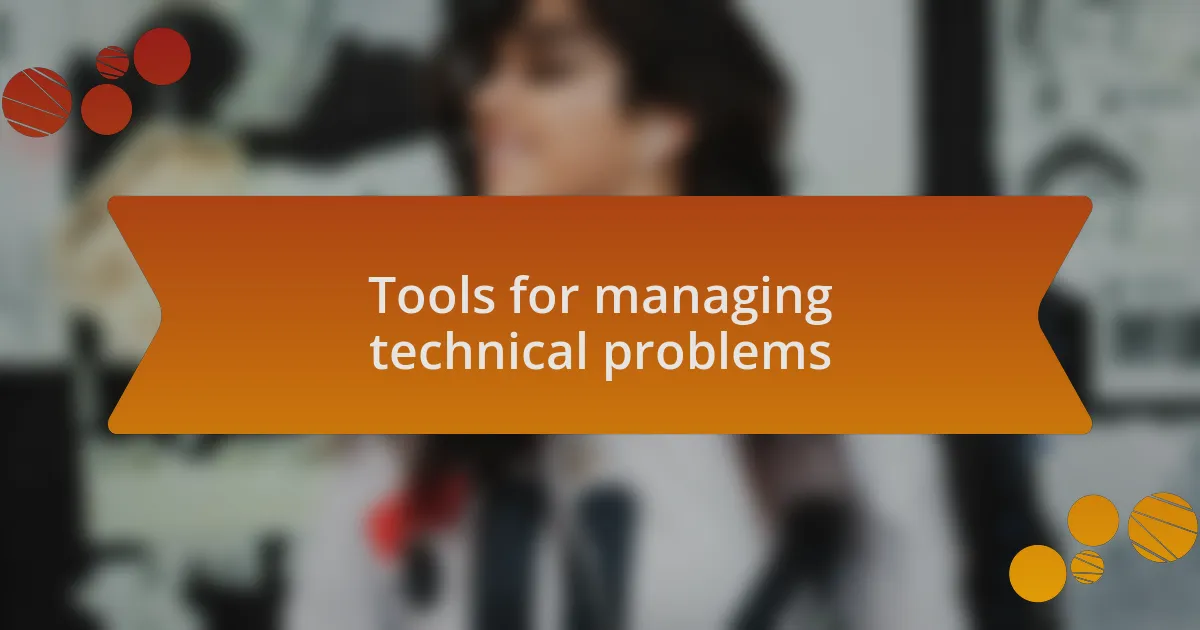
Tools for managing technical problems
When managing technical difficulties live, having the right tools at your disposal can make all the difference. I’ve found that a solid troubleshooting checklist is invaluable. In the heat of the moment, it’s easy to overlook basic steps, but having a physical list helps keep my mind focused. I remember a time when I was fumbling with cables, and referring back to my checklist helped me find the issue quickly.
Another tool I swear by is a reliable communication system with my team. Headsets or walkie-talkies can be lifesavers, especially when things start going haywire. I recall a night when my visual engineer was able to alert me about a malfunction from across the venue, allowing us to tackle the issue immediately. It’s like having a safety net when the unexpected hits.
Of course, I can’t stress the importance of backup equipment enough. Having an extra microphone or a spare set of cables isn’t just good practice; it’s essential. There’s nothing worse than experiencing a technical failure and realizing you’re unprepared. I once had a backup speaker ready that saved a set when the primary one failed. It felt like a weight lifted off my shoulders as the music flowed again, reminding me how crucial it is to be prepared for the unexpected.
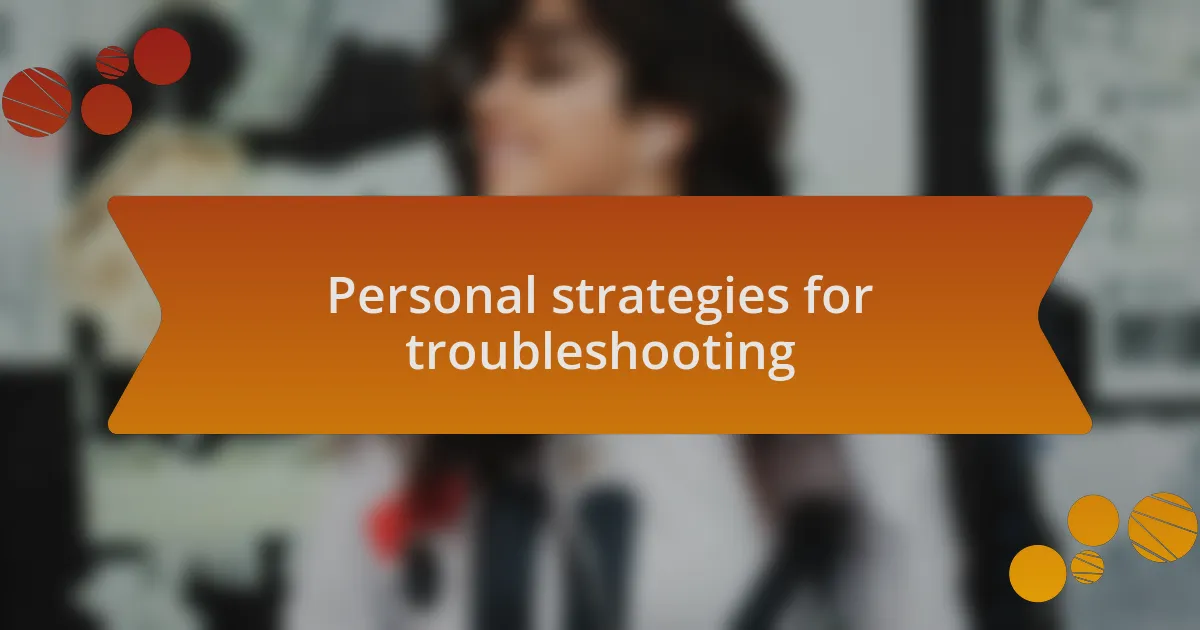
Personal strategies for troubleshooting
When troubleshooting, I always start by taking a deep breath and assessing the situation. Panic can cloud judgment, so I remind myself to stay calm. I once faced a power outage mid-set, and by pausing to gather my thoughts, I was able to quickly identify the main power source and redirect our energy to a backup generator. It realized then that a level-headed approach is just as crucial as the technical skills we possess.
Another strategy I incorporate is engaging my instincts. Over time, I’ve developed a knack for diagnosing issues just by the sound. One night, during a particularly rowdy crowd, I noticed a distortion that suddenly popped up. Trusting my ears, I adjusted the mixer on the fly, which not only solved the problem but also kept the energy high. It’s moments like these that reinforce my belief in relying on intuition backed by experience.
Lastly, I advocate for collaboration; there’s immense power in teamwork. When problems arise, I always turn to my crew for insight or fresh perspectives. I recall a challenging evening where I struggled to decode a complex lighting malfunction. After asking for help, my lighting technician pointed out a connection I had overlooked, leading us to a quick fix. Sometimes, a different set of eyes can be the key to overcoming obstacles, don’t you think?
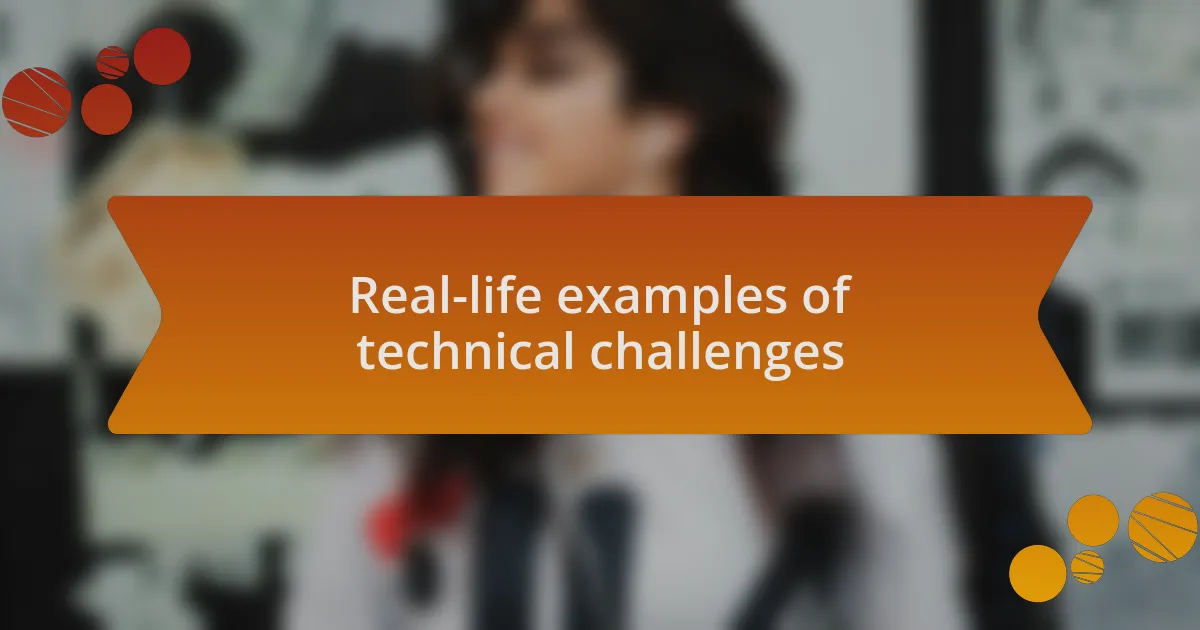
Real-life examples of technical challenges
I remember one night when the sound system just stopped working mid-performance. The moment the silence hit, I felt a wave of panic wash over me. My heart raced as I scanned the room, but then I noticed a small LED light blinking on the mixer. It turned out to be a loose cable. I quickly reconnected it, and the music flowed back in. It was a reminder of how our connection to equipment can often be more fragile than we’d like to believe.
During another gig, I encountered a problem with the DJ software that crashed unexpectedly. The anticipation in the crowd quickly shifted to confusion and frustration. I had to think fast; I had my laptop on standby for emergencies. I leapt into action and rebooted the program, all while engaging the audience in a playful way. “Who doesn’t love a little drum roll?” I joked, and miraculously, the software restored without a hitch. It’s funny how the pressure can lead to creativity, isn’t it?
On a different occasion, our lighting rig malfunctioned, plunging the dance floor into darkness. I could feel the collective sigh of disappointment from the crowd. Instead of panicking, I took a step back and communicated with my team. We regrouped and quickly switched to alternative lights we had set aside for such emergencies. That experience reinforced for me the importance of being prepared and keeping calm under pressure. Have you ever found yourself in a similar situation, relying on your team to save the moment?
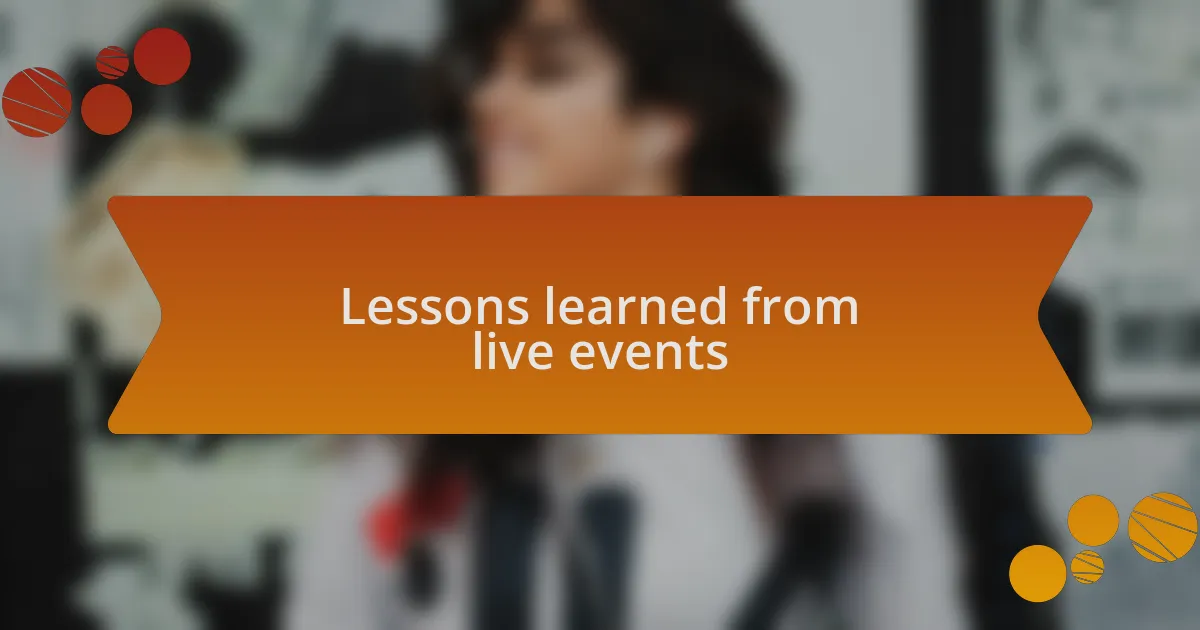
Lessons learned from live events
There’s a lesson in adaptability that I’ve learned from live events. I once showed up for a set where the venue’s acoustics turned out to be completely different from what I was used to. With each adjustment I made, I felt the pressure to maintain the vibe of the night, but it ultimately taught me to read the room creatively. Have you ever had to switch your approach at the last minute?
Another significant takeaway for me is the value of communication. During one particularly hectic night, I had a miscommunication with the sound engineer about the cue for the lights. In that moment, I could feel the tension rising as everything spiraled out of sync. To rectify it, I reached out for a quick chat, and we were able to get back on track. That experience made me realize how important it is to maintain clear lines of communication in high-pressure situations. It’s fascinating how a small conversation can alter the course of an entire event, isn’t it?
Lastly, I’ve learned to embrace the unexpected. There was a night when we experienced a total power outage just as the headlining act was about to take the stage. Instead of being discouraged, I turned to the crowd and started an impromptu acoustic set with one of the support artists. The energy shifted; it became a special moment that I doubt anyone in attendance will forget. Sometimes, the most memorable experiences stem from chaos, and those are the moments where real connection happens. How has unpredictability shaped your experiences in live settings?